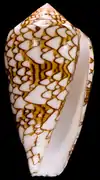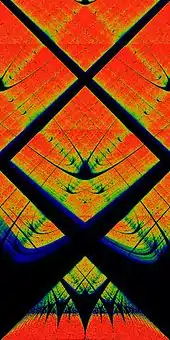Svetlana Jitomirskaya
Svetlana Yakovlevna Jitomirskaya (born June 4, 1966) is a Soviet-born American mathematician working on dynamical systems and mathematical physics.[1][2] She is a distinguished professor of mathematics at the University of California, Irvine.[3] She is best known for solving the ten martini problem along with mathematician Artur Avila.[4][5]
Svetlana Jitomirskaya | |
|---|---|
.jpg.webp) | |
| Born | June 4, 1966 |
| Alma mater | Moscow State University |
| Known for | Ten martini problem |
| Awards | Ruth Lyttle Satter Prize in Mathematics (2005) Dannie Heineman Prize for Mathematical Physics (2020) |
| Scientific career | |
| Fields | Mathematics |
| Institutions | University of California, Irvine |
| Thesis | Spectral and Statistical Properties of Lattice Hamiltonians (1991) |
| Doctoral advisor | Yakov Sinai |
| Influences | Vladimir Arnold |
Education and career
Jitomirskaya was born and grew up in Kharkiv. Both her mother, Valentina Borok, and her father, Yakov Zhitomirskii, were professors of mathematics.[1]
Her undergraduate studies were at Moscow State University, where she was a student of, among others, Vladimir Arnold and Yakov Sinai.[1] She obtained her Ph.D. from Moscow State University in 1991 under the supervision of Yakov Sinai.[6] She joined the mathematics department at the University of California, Irvine in 1991 as a lecturer, and she became an assistant professor there in 1994 and a full professor in 2000.[2]
Honours
In 2005, she was awarded the Ruth Lyttle Satter Prize in Mathematics, "for her pioneering work on non-perturbative quasiperiodic localization".[7]
She was an invited speaker at the 2002 International Congress of Mathematicians, in Beijing.[8]
She received a Sloan Fellowship in 1996.[9]
In 2018 she was named to the American Academy of Arts and Sciences.[10]
Jitomirskaya is the 2020 winner of the Dannie Heineman Prize for Mathematical Physics, becoming the second woman to win the prize and the first woman to be the sole winner of the prize. The award citation credited her "for work on the spectral theory of almost-periodic Schrödinger operators and related questions in dynamical systems. In particular, for her role in the solution of the Ten Martini problem, concerning the Cantor set nature of the spectrum of all almost Mathieu operators and in the development of the fundamental mathematical aspects of the localization and metal-insulator transition phenomena."[5]
Selected publications
- Jitomirskaya, Svetlana Ya. (1999), "Metal-insulator transition for the almost Mathieu operator", Annals of Mathematics, Second Series, 150 (3): 1159–1175, arXiv:math/9911265, Bibcode:1999math.....11265J, doi:10.2307/121066, JSTOR 121066, MR 1740982, S2CID 10641385.
- Avila, Artur; Jitomirskaya, Svetlana (2009), "The Ten Martini Problem", Annals of Mathematics, Second Series, 170 (1): 303–342, arXiv:math/0503363, doi:10.4007/annals.2009.170.303, MR 2521117.
- Jitomirskaya, Svetlana; Last, Yoram (1999), "Power-law subordinacy and singular spectra. I. Half-line operators", Acta Mathematica, 183 (2): 171–189, doi:10.1007/BF02392827, MR 1738043.
References
- O'Connor, John J.; Robertson, Edmund F., "Svetlana Jitomirskaya", MacTutor History of Mathematics archive, University of St Andrews.
- Jitomirskaya's CV
- "Distinguished professors". University of California, Irvine. Retrieved 2020-03-06.
- Avila, Artur; Jitomirskaya, Svetlana (2006). "Solving the Ten Martini Problem". Mathematical Physics of Quantum Mechanics. Lecture Notes in Physics. 690. pp. 5–16. arXiv:math/0503363. doi:10.1007/3-540-34273-7_2. ISBN 978-3-540-31026-6. S2CID 55259301.
- Pignataro, Anthony (October 23, 2019), "UC Irvine mathematics professor makes history with award", OC Weekly
- Svetlana Jitomirskaya at the Mathematics Genealogy Project
- "2005 Satter Prize" (PDF), Notices of the American Mathematical Society, 52 (4): 447–448, April 2005.
- http://www.mathunion.org/db/ICM/Speakers/SortedByCongress.php
- "Past Fellows".
- "Around Town: UC Irvine professor named fellow of American Academy of Arts and Sciences", Los Angeles Times, April 21, 2018
External links
- Home page of Svetlana Jitomirskaya
- Riddle, Larry (January 10, 2014), "Svetlana Jitomirskaya", Biographies of Women Mathematicians, Agnes Scott College, retrieved 2015-10-22.
- UCI Distinguished Mid-Career Award for Research 2004–2005 at the Wayback Machine (archived September 3, 2004)

